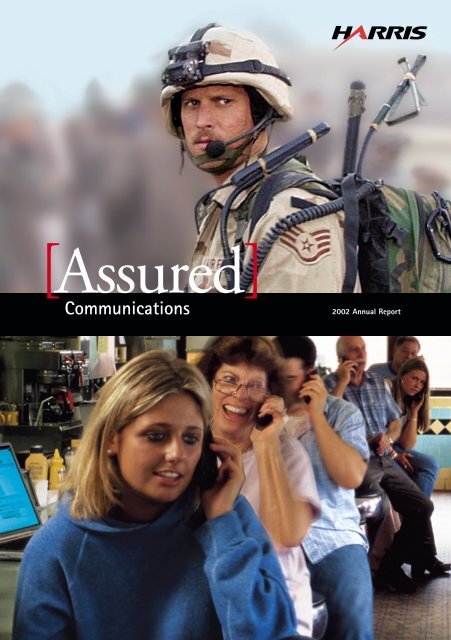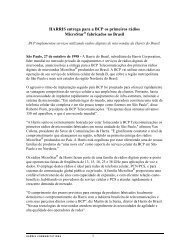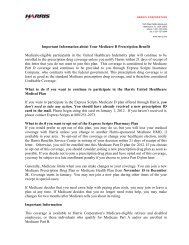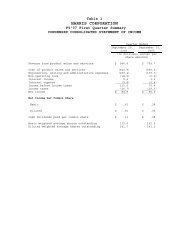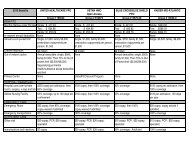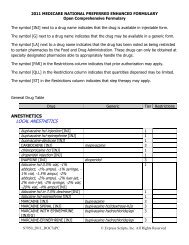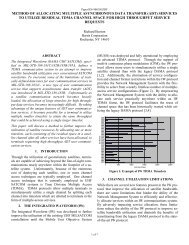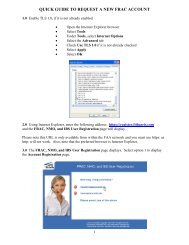Harris 2002 Annual Report
Harris 2002 Annual Report
Harris 2002 Annual Report
Create successful ePaper yourself
Turn your PDF publications into a flip-book with our unique Google optimized e-Paper software.
[Assured]<br />
Communications<br />
<strong>2002</strong> <strong>Annual</strong> <strong>Report</strong>
Financial Highlights<br />
Dollars in millions except per share amounts<br />
<strong>2002</strong> (1) 2001 (2)<br />
Revenues $1,875.8 $1,955.1<br />
Net Income 82.6 21.4<br />
Per Share Net Income 1.25 .32<br />
Return on Revenues 4.4% 1.1%<br />
Return on Equity 7.3% 1.7%<br />
Diluted Average Shares Outstanding (Millions) 66.3 67.0<br />
Number of Record Shareholders 8,834 9,318<br />
Stock Price Performance*<br />
Fiscal Year Ending June 28, <strong>2002</strong><br />
HARRIS +31.73%<br />
DJIA -12.75%<br />
NASDAQ -31.90%<br />
S&P 500 -19.96%<br />
Russell 2000 -7.17%<br />
*Source: Bloomberg.com<br />
GOVERNMENT<br />
COMMUNICATIONS<br />
<strong>Harris</strong> conducts advanced research<br />
studies, develops prototypes, and<br />
produces, integrates, and supports<br />
state-of-the-art, highly<br />
reliable communications and<br />
information systems that solve<br />
the mission-critical communications<br />
challenges of its military<br />
and government customers. This<br />
business also provides the technology<br />
base for the company’s<br />
diverse commercial businesses.<br />
RF<br />
COMMUNICATIONS<br />
<strong>Harris</strong> is a leading worldwide<br />
supplier of tactical radio<br />
communications products,<br />
systems, and networks to military<br />
and government organizations,<br />
and a provider of high-grade<br />
encryption solutions. These<br />
solutions address the demanding<br />
requirements of U.S., NATO, and<br />
Partnership for Peace forces, as<br />
well as government agencies<br />
and embassies around the world.<br />
Business Segments<br />
BROADCAST<br />
COMMUNICATIONS<br />
<strong>Harris</strong> is the leading supplier<br />
of broadcast products and<br />
end-to-end systems for delivery,<br />
automation, and management<br />
of audio, video, and data. Setting<br />
the pace in the transition from<br />
analog to digital technology,<br />
<strong>Harris</strong> offers a complete range<br />
of studio, program transport,<br />
and transmission products<br />
and systems.<br />
Percent Revenue By Business Segment<br />
3%<br />
15%<br />
19%<br />
49%<br />
14%<br />
(1) Results for fiscal <strong>2002</strong> include a $6.8 million after-tax gain on the sale of our<br />
minority interest in our GE <strong>Harris</strong> Energy Control Systems, LLC joint venture, a<br />
$6.6 million after-tax write-down of our investment interest in Terion, Inc., and a<br />
$2.4 million after-tax write-down of marketable securities.<br />
(2) Results for fiscal 2001 include an after-tax charge of $73.5 million for the<br />
write-off of purchased in-process research and development, a $21.7 million<br />
after-tax gain on the sale of our minority interest in our GE-<strong>Harris</strong> Railway<br />
Electronics, LLC joint venture, a $13.1 million after-tax write-down of<br />
marketable securities, and goodwill amortization of $14.4 million after tax.<br />
MICROWAVE<br />
COMMUNICATIONS<br />
<strong>Harris</strong> is the largest supplier<br />
of microwave radio systems in<br />
North America and a global<br />
leader in broadband wireless<br />
solutions to cellular, PCS, and<br />
private telecom networks. Its<br />
product line, the broadest in<br />
the industry, includes microwave<br />
and millimeter wave systems<br />
for point-to-point and pointto-multipoint<br />
architectures.<br />
Government<br />
Government Communications<br />
RF Communications<br />
Broadcast<br />
Broadcast Communications<br />
Telecommunications<br />
Microwave Communications<br />
Network Support<br />
NETWORK<br />
SUPPORT<br />
<strong>Harris</strong> delivers management,<br />
test, and maintenance products,<br />
systems, and software for multivendor,<br />
multiprotocol networks<br />
of public and private communications<br />
service providers.<br />
Solutions address the needs of<br />
operations, maintenance, and<br />
installation professionals in<br />
telecommunications, broadcast,<br />
and defense markets around<br />
the world.
Assured Communications: For many years, the engineering community within<br />
<strong>Harris</strong> has characterized the value proposition of our products and systems as<br />
“assured communications.” Our equipment assures that soldiers in harm’s way<br />
are never out of touch, that TV and radio stations don’t go off the air, and that<br />
voice and data networks are never offline. In record numbers, old and new<br />
customers are trusting <strong>Harris</strong> to help them perform the increasingly complex<br />
task of communications.<br />
[Letter]<br />
To Shareholders<br />
Economic trends and other events have not been positive over the past 12 months. However, the restructuring<br />
of <strong>Harris</strong>, initiated three years ago, has positioned the company to succeed even in these troubled<br />
times. Our products and systems were used effectively in the recovery efforts following September 11th<br />
and are in great demand for the ongoing War on Terrorism. Our digital products are leading the charge<br />
to a new era in TV and radio broadcasting. The company’s diversified mix of businesses is helping to ensure<br />
that our telecom businesses have the stability to survive an extended market downturn and to emerge from<br />
that cycle even stronger.<br />
The company’s results for fiscal <strong>2002</strong> were solid, given the very difficult market environment<br />
for communications equipment companies. Results in our government, tactical radio, and broadcast<br />
businesses were strong. Market weakness in our telecom businesses was partially offset by on-going<br />
cost-cutting efforts. Overall, sales declined a modest 4 percent compared to the prior year, but net<br />
income grew to $82.6 million (1) (see footnote on previous page).<br />
Government Communications Systems<br />
The Government Communications Systems segment had strong gains in revenue and<br />
income as a result of increased defense spending and <strong>Harris</strong>’ expertise in developing<br />
critical communications systems. Fiscal <strong>2002</strong> segment sales were $924 million and<br />
grew 9 percent, compared to the prior year. Income increased 21 percent. The<br />
long-term outlook for this business has strengthened greatly. The business provides<br />
airborne, spaceborne, and ground communications systems for defense and other<br />
government agencies. This segment is experiencing a remarkable contract win rate and<br />
continues to benefit from performance incentives and from lower operating costs.<br />
Fiscal <strong>2002</strong> orders in the segment increased 10 percent and exceeded sales. During<br />
the year, the company won communications systems contracts across a broad base<br />
of programs, including Ballistic Missile Defense, weather data systems for the<br />
FAA, ground communications terminals for defense, key military aircraft<br />
platforms, and the Army’s Multiple Launch Rocket System.<br />
Phillip W. Farmer<br />
Chairman of the Board,<br />
President and<br />
Chief Executive Officer
Letter To Shareholders<br />
2<br />
The largest wins during the year included the selection of <strong>Harris</strong> to provide avionics equipment<br />
on the Joint Strike Fighter, a program valued at approximately $2 billion over the next 20 years, and a<br />
$200 million contract with a new customer, the U.S. Census Bureau. <strong>Harris</strong> will provide the Census<br />
Bureau with a nationwide computer database of addresses and locations where people live and work.<br />
The good news continued following the close of the fiscal year. In the first quarter of fiscal 2003,<br />
<strong>Harris</strong> won the largest contract in its history. The company will modernize telecommunications for the<br />
FAA in a 15-year program that has an initial value of $1.7 billion, with the potential to reach $3.5 billion<br />
as options are exercised. The FAA contract, combined with the company’s second quarter fiscal <strong>2002</strong><br />
win of a $2 billion position on the Joint Strike Fighter, represent the two largest programs in the<br />
company’s history.<br />
In the first quarter of fiscal 2003, <strong>Harris</strong> has been selected for several high-profile programs in<br />
what has been an unprecedented period of contract wins for our government business. In July and<br />
August <strong>2002</strong>, <strong>Harris</strong> secured positions on government programs with a combined potential value of<br />
more than $2.5 billion, and new opportunities continued to surface as budgets for key government<br />
customers increase to address defense and homeland security initiatives.<br />
RF Communications<br />
The RF Communications segment performed brilliantly once again, setting new records in all categories.<br />
Fiscal <strong>2002</strong> sales were $258 million and increased 16 percent compared to the prior year. Income soared<br />
59 percent, and orders almost doubled. <strong>Harris</strong>’ Falcon ® II family of secure tactical radio systems provides<br />
advanced communications for U.S., NATO, and Partnership for Peace forces, and is being used with great<br />
success in the War on Terrorism around the globe.<br />
The business began fiscal <strong>2002</strong> with its largest win ever when it was selected to provide 10,000 HF<br />
radios for the United Kingdom’s Bowman Tactical Radio Programme. The five-year contract has a value of<br />
more than $200 million. Bowman is one of the most important land-based military projects in recent U.K.<br />
history and positions <strong>Harris</strong> to expand its tactical radio footprint throughout Europe.<br />
At the end of the fiscal year, RF Communications won a significant position on another huge<br />
program that the Department of Defense calls its “Radio of the Future” – the Joint Tactical Radio System<br />
(JTRS). <strong>Harris</strong> was selected as a subcontractor to Boeing and expects to provide more than $500 million<br />
in system design, development, and production for the $4 billion first “Cluster” of a four-cluster JTRS<br />
development program that will provide advanced radio communications for all U.S. military forces.<br />
RF Communications also plans to bid on the JTRS Clusters 2-4, which will be awarded over the next<br />
12-24 months. The remaining Clusters have a total value of approximately $5 billion.<br />
The long-term outlook for the RF Communications business has never been brighter.<br />
Broadcast Communications<br />
The Broadcast Communications segment continued steady growth in fiscal <strong>2002</strong>. <strong>Harris</strong> solidified its<br />
leadership position in helping U.S. TV broadcasters make the transition to digital standards. The business<br />
had fiscal <strong>2002</strong> sales of $355 million, increasing 5 percent over record results<br />
in the prior year. Income, also a new record, grew 6 percent compared to fiscal<br />
2001. While sales from the digital rollout were robust, disappointing<br />
advertising revenues, resulting from the economic slowdown, did prompt some<br />
broadcasters to delay purchases of automation and studio systems during the<br />
year, limiting sales for those <strong>Harris</strong> product lines.<br />
In the fourth quarter, broadcast industry momentum was evident as<br />
<strong>Harris</strong> booked orders surpassing $100 million. We saw a surge in digital<br />
equipment purchases by non-commercial TV stations – PBS stations – which<br />
have begun their own scramble to meet the FCC digital deadline for PBS<br />
stations set for May 2003.<br />
The FCC has remained steadfast on its analog to digital conversion<br />
schedule and, by mid-summer, approximately half of the nation’s 1,600<br />
International vs.<br />
Domestic Business<br />
(percent of revenues)<br />
International 22%<br />
Domestic<br />
78%
oadcasters had ordered equipment that would allow them to meet at least the minimum first-step<br />
requirements of the FCC’s mandated rollout schedule. The good news is that strong market opportunities<br />
lie ahead as half of the domestic digital equipment volume has yet to be ordered. In addition, the international<br />
market rollout of digital equipment is still in its early stages.<br />
Looking ahead to fiscal 2003, we expect the continuation of the digital TV transition, and the beginning<br />
of the transition to digital radio standards. <strong>Harris</strong> helped to develop the new standards for radio and has<br />
introduced a new transmitter and other products for the digital transition.<br />
Microwave Communications<br />
International markets for telecommunications equipment continued to decline during fiscal <strong>2002</strong>. The<br />
primary problem was the absence of capital resources to finance the build-out of cellular networks. Fiscal<br />
<strong>2002</strong> sales were $289 million in our Microwave Communications segment, declining 33 percent compared to<br />
the prior year, and the business had a loss of $17.4 million. The North American market was the only bright<br />
spot, with sales remaining healthy. International sales were down 48 percent. We remain confident in the<br />
fundamentals of the microwave business and its eventual return to growth. Near term, we continue to reduce<br />
costs to cope with the current international market weakness.<br />
In fiscal <strong>2002</strong>, we introduced next-generation microwave radios that should have great implications for<br />
the long-term success of this business. Our point-to-multipoint (PMP) products, which provide last mile<br />
wireless voice and data services, are finding growing acceptance in international markets. During the year,<br />
<strong>Harris</strong> won three contracts for its PMP products in Malaysia, Greece, and Sri Lanka. The products provide<br />
toll-quality voice capability and high-speed Internet connection. We believe these initial contracts will<br />
lead to future orders in international markets.<br />
Network Support<br />
The Network Support segment saw sales drop sharply in fiscal <strong>2002</strong> to $57 million, down 53 percent from<br />
the prior year, and the business suffered an operating loss of $10.3 million. Capital spending by the U.S.<br />
Regional Bell Operating Companies (RBOCs) remained depressed, significantly lowering sales of our<br />
industry-leading telecom tools and test-set products. Demand for our network management system,<br />
NetBoss™, continued to decline due to significantly lower capital spending for telecom software worldwide.<br />
Although spending by the RBOCs remains very low, <strong>Harris</strong> has introduced a new line of digital test<br />
sets that has been standardized by the RBOCs and should provide a good stream of revenue when equipment<br />
purchases return to historical levels. In addition, the company will soon complete the first installation of<br />
its new enterprise solution, and NetBoss is expected to be used in several major programs won by our<br />
Government, Broadcast, and Microwave Communications<br />
businesses, which should help to improve results in our<br />
Network Support business.<br />
Strong Cash Flow, Low Debt<br />
Cash flow from operations was a positive $207 million<br />
for fiscal <strong>2002</strong>, versus a net use of cash by operations of<br />
$27 million in the prior year. All five business segments<br />
generated cash during the year. <strong>Harris</strong> reduced debt by<br />
$111 million, and at year-end had a debt-to-capital ratio<br />
of 21.2 percent, versus 27.3 percent at the end of the<br />
prior year. The improved cash flow position results in<br />
large part from working capital reduction programs across<br />
all business segments. The company’s positive cash flow<br />
position and strong balance sheet provide <strong>Harris</strong> with<br />
the flexibility to manage the company from a proactive<br />
position through a variety of economic cycles.<br />
Corporate Policy Committee<br />
(Left to Right) Bryan R. Roub, Senior Vice President and CFO;<br />
Richard L. Ballantyne, Vice President, General Counsel and Corporate<br />
Secretary; Phillip W. Farmer, Chairman and CEO; Nick E. Heldreth, Vice<br />
President, Human Resources and Corporate Relations<br />
3
Letter To Shareholders<br />
4<br />
Dividend Increase<br />
At its August <strong>2002</strong> meeting, the Board of Directors declared a quarterly dividend of 8 cents per share,<br />
which increases the previous quarterly dividend of 5 cents per share by 60 percent. The increase in the<br />
cash dividend brings the annual rate to 32 cents per share, compared to the previous rate of 20 cents per<br />
share. The increase in the quarterly payout results from the company’s solid financial performance in fiscal<br />
<strong>2002</strong>, positive cash flow from operations, and an improving business outlook. We are pleased to enhance<br />
shareholder value by increasing the total yield on the company’s common shares.<br />
Outlook<br />
Fiscal 2003 has begun on several upbeat notes with two big wins in our Government Communications<br />
Systems business. We anticipate further good news in both our Government Communications and RF<br />
Communications businesses. In our Broadcast business, we intend to continue to lead the digital transition<br />
in TV and radio in the U.S. and around the world. The company’s diversified mix of businesses is allowing<br />
us to overcome the current downturn in telecommunications, while continuing to provide our shareholders<br />
with a good return on their investment in <strong>Harris</strong>. For fiscal 2003, we expect to see continued growth in<br />
earnings driven by our leadership positions in key market segments.<br />
Board of Directors<br />
During the fiscal year, <strong>Harris</strong> elected two new directors with outstanding experience and management depth.<br />
David B. Rickard, 55, is the executive vice president and chief financial officer of CVS Corporation, the<br />
nation’s largest drugstore company. Lewis Hay III, 47, is chairman, president, chief executive officer, and former<br />
chief financial officer of FPL Group, Inc., one of the nation’s largest providers of electricity-related services.<br />
John T. Hartley retired from the Board in March. He joined <strong>Harris</strong> in 1956 as a research engineer,<br />
was named chief executive officer in 1986, and chairman of the board in 1987. We thank Jack for his vast<br />
contributions and steadfast dedication to the company for more than 46 years.<br />
Public Trust<br />
In closing, I’d like to acknowledge what is being described as a general lack of confidence in the way many<br />
public companies are being operated. While I believe that the vast majority of U.S. companies are operated<br />
with the best interests of shareholders in mind, I will restrict my comments to <strong>Harris</strong>.<br />
The senior management team of <strong>Harris</strong> is extremely mindful of the trust that shareholders, customers,<br />
employees, and suppliers place in the company, and we operate the company accordingly. We believe our<br />
accounting and business conduct practices adhere to both the letter and spirit of the law.<br />
We also believe our corporate governance principles are above reproach. Our Board of Directors is<br />
90 percent controlled by independent outside members. I am the only <strong>Harris</strong> employee on the 10-member<br />
board. The Audit, Corporate Governance, Management Development and Compensation, and Business<br />
Conduct committees have only independent directors, and they always have. We have an outstanding<br />
Board that is dedicated to the interests of all shareholders.<br />
There is a reason why <strong>Harris</strong> has been in business for 107 years. We understand the rules and we<br />
adhere to them.<br />
Sincerely,<br />
Phillip W. Farmer<br />
Chairman of the Board,<br />
President and Chief Executive Officer August 24, <strong>2002</strong>
[<strong>Harris</strong>]<br />
<strong>Harris</strong> will benefit from a<br />
sustained buildup in U.S.<br />
Government spending, the<br />
continuing rollout of digital<br />
broadcast equipment<br />
worldwide, and the eventual<br />
rebound of telecom markets.<br />
5
[Government]<br />
Communications<br />
<strong>Harris</strong> provides highly reliable communications<br />
and information systems that solve the<br />
mission-critical challenges of its defense<br />
and other government customers.<br />
Robert K. Henry<br />
President,<br />
Government Communications Systems
To Catch<br />
A Crook<br />
Crime Information:<br />
Millions of pieces of law<br />
enforcement information<br />
are continuously updated<br />
and stored in “information<br />
silos” like the one<br />
pictured here.<br />
[Assured Communications]<br />
At the FBI’s National Crime Information Center<br />
in Clarksburg, West Virginia<br />
The FBI’s National Crime Information Center (NCIC) was established in 1967<br />
to assist federal, state, and local criminal justice agencies in positively identifying<br />
suspected criminals. The NCIC features a computerized index of more than 39 million<br />
records on fugitives, missing persons, and stolen property. It is available over secure<br />
telecom lines to 80,000 law enforcement agencies and 738,000 law enforcement<br />
officers, 24 hours a day. For example, when an officer stops an individual for a traffic<br />
violation, a combination of the license plate number, auto description, or occupant’s<br />
name and date of birth is matched against the NCIC database in less than a second.<br />
A growing number of patrol vehicles now have laptop computers and fingerprint<br />
scanners, which allow officers to electronically receive mug shots and to match<br />
fingerprints against those in the NCIC database.<br />
<strong>Harris</strong> modernized the database, launching NCIC 2000 in 1999 at the FBI’s<br />
new Criminal Justice Information Services Division in Clarksburg, West Virginia. New<br />
software and hardware systems have allowed transactions to accelerate and processing<br />
times to drop. During 1967, the first year of system implementation, approximately<br />
2 million inquiries were processed. By comparison, in 1999 the database processed<br />
an average 2.1 million inquiries per day. NCIC 2000 has catapulted system capabilities<br />
to a range approaching 4 million transactions per day. Response time to process an<br />
inquiry is approximately 0.15 seconds. Through NCIC 2000, technology has extended<br />
the long arm of the law.<br />
7
Government Communications<br />
8<br />
On July 15, <strong>2002</strong>, <strong>Harris</strong> was awarded a 15-year contract to integrate and modernize the FAA’s<br />
Telecommunications Infrastructure (FTI). The contract has a potential value of $3.5 billion,<br />
representing the largest award in company history. It was a huge win against two major competitors,<br />
but, quite frankly, it was not a huge surprise.<br />
<strong>Harris</strong> has a strong relationship with the FAA as a systems integrator that dates back two<br />
decades. The company has been supplying most of the weather data systems that support the<br />
FAA’s air traffic controllers. In a very successful program during the 1990s, <strong>Harris</strong> modernized<br />
the FAA’s Voice Switching and Control System (VSCS) used by controllers to communicate<br />
with pilots and other controllers.<br />
The FTI program will improve operations at more than 5,000 FAA facilities nationwide,<br />
while reducing operating costs, enhancing network security, and improving telecom network<br />
performance, reliability, and quality. <strong>Harris</strong> will provide systems integration expertise and<br />
manage the team of telecom industry giants BellSouth Corporation, Qwest Communications<br />
International Inc., SBC Communications, Inc., Sprint, Verizon Communications, and<br />
Raytheon Technical Services Company.<br />
Joint Strike Fighter<br />
During the past 12 months, the Government Communications Systems business amassed an<br />
impressive list of contract wins in addition to the FTI program. Earlier in fiscal <strong>2002</strong>, the company<br />
won a significant position on the Department of Defense’s Joint Strike Fighter (JSF) program,<br />
which is led by Lockheed Martin. <strong>Harris</strong> expects to provide more than $2 billion of advanced<br />
avionics systems work for the new stealth aircraft, which will be a cornerstone of future defense<br />
capabilities for the U.S. and its allied partners.<br />
U.S. Census Bureau<br />
Toward the end of the fiscal year, <strong>Harris</strong> won an eight-year,<br />
$200 million contract to integrate computer databases for a new<br />
customer – the U.S. Census Bureau. The program will combine a<br />
database of complete and current lists of all addresses and locations<br />
where people live and work – covering an estimated 115 million<br />
Joint Strike Fighter: <strong>Harris</strong> is<br />
supplying next-generation avionics<br />
systems design, development, and<br />
production for the F-35 Joint Strike<br />
Fighter (JSF) aircraft. JSF represents<br />
the cornerstone of future defense<br />
capabilities for the U.S. and its<br />
allied partners.<br />
Segment Highlights<br />
(in millions)<br />
Sales<br />
Income<br />
Fiscal <strong>2002</strong><br />
$924.4<br />
$ 85.5
esidences, as well as 60 million businesses and other structures in the<br />
U.S. – with a database of information regarding streets, rivers, railroads,<br />
and other geographical features. All of this information will be available<br />
to census takers during the 2010 census, helping to significantly improve<br />
the quality and accuracy of the census results.<br />
FAA Communications:<br />
<strong>Harris</strong> will integrate and<br />
modernize the FAA’s telecommunications<br />
infrastructure<br />
under a $1.7 billion contract<br />
that will result in improved<br />
operations, reduced costs, and<br />
enhanced network security at<br />
FAA facilities nationwide.<br />
Other Program Wins<br />
Other major programs awarded to <strong>Harris</strong> during the year included<br />
ground stations and antenna systems for military satellite communications systems, weather data<br />
processing systems for the FAA, missile data links, improved fire control systems for multiple launch<br />
rocket systems, and advanced avionics for military aircraft platforms including the F-22 Raptor<br />
and F/A-18E/F Super Hornet fighters, and the RAH-66 Comanche helicopter. <strong>Harris</strong> also is<br />
developing and testing critical components such as the In-Flight Interceptor Communications<br />
System (IFICS) Data Terminal for the Ground-based Midcourse Defense (GMD) program –<br />
formerly known as National Missile Defense. The IFICS provides critical communications<br />
between ground command and control systems and ballistic missile interceptors.<br />
In the first quarter of fiscal 2003, <strong>Harris</strong> was selected for several major programs. These<br />
include a potential $355 million operations and maintenance services program supporting<br />
the U.S. Air Force Satellite Control Network’s communications functions, and wireless<br />
transmit system architecture supporting the U.S. Army’s Warfighter Information Network –<br />
Tactical program. The long-term outlook for the business remains very positive.<br />
Census Bureau: Advanced <strong>Harris</strong><br />
imaging, cartographic, and database<br />
processing technologies will<br />
greatly improve the quality and<br />
accuracy of the digital databases<br />
used by U.S. Census takers.<br />
[<br />
Ballistic Missile Defense:<br />
The <strong>Harris</strong>-developed In-flight<br />
Interceptor Communications<br />
System is playing a crucial role<br />
in the nation’s Ground-based<br />
Midcourse Defense (GMD)<br />
system. <strong>Harris</strong> has participated<br />
in the past three successful<br />
missile intercept tests.<br />
]<br />
FTI program<br />
$3.5<br />
Billion<br />
35,000 Circuits<br />
5,000 FAA facilities<br />
9
This business is a clear beneficiary of the<br />
worldwide focus on the War on Terrorism<br />
and the long-term trend toward networked<br />
battlefield communications.<br />
[RF]<br />
Communications<br />
In July 2001, <strong>Harris</strong>’ RF Communications business won the largest tactical radio contract in its<br />
history (superceded by a bigger win in June <strong>2002</strong>). The business expects to provide 10,000 HF<br />
radios to the United Kingdom Ministry of Defence for one of the most important land-based<br />
military projects in recent U.K. history – the Bowman Programme. <strong>Harris</strong>’ position on the<br />
contract is valued at $200 million.<br />
Bowman Programme<br />
It was a big win against steep odds. Although <strong>Harris</strong> team members were confident their radio<br />
had superior capabilities, the contract clearly favored in-country suppliers with political clout<br />
and local manufacturing operations. <strong>Harris</strong> is a subcontractor to General Dynamics (GD) on the<br />
program, and the <strong>Harris</strong> radio accounts for just 15 percent of the total Bowman project, which is<br />
valued at $2.4 billion. Nevertheless, <strong>Harris</strong> took the lead to integrate a prototype U.K. encryption<br />
module in <strong>Harris</strong>’ industry-leading Falcon ® II radio.<br />
[<br />
The technical analysts at the U.K. Ministry of Defence were <strong>Harris</strong> is supplying<br />
astounded that <strong>Harris</strong> was able to demonstrate a fully encrypted<br />
radio so early in the selection process. <strong>Harris</strong> won the day, and<br />
GD won the contract.<br />
Thousand]<br />
TEN<br />
Radios for U.K. forces<br />
Chester A. Massari<br />
President,<br />
RF Communications
<strong>Harris</strong> continues to surprise and delight its customers and has<br />
become the world leader in secure tactical military radios. U.S.,<br />
NATO, and Partnership for Peace forces use the Falcon II on six<br />
continents. The radios are also used by government agencies and<br />
embassies worldwide.<br />
Software-Defined Radio<br />
Falcon II capabilities include leading-edge, software-defined radio technology, which offers increased<br />
flexibility in supporting a variety of wireless communications protocols without the need to change<br />
hardware. The high software content of the radio permits rapid manufacturing, which is critical<br />
when demand for the radios surges. <strong>Harris</strong> responded in record time to customer requests following<br />
the attacks on September 11, and the Falcon II has been used extensively and successfully in the<br />
War on Terrorism.<br />
During the fiscal year, <strong>Harris</strong> won contracts from first-in forces such as the U.S. Army’s<br />
Initial Brigade Combat Team, the Army’s 82nd Airborne Division, the U.S. Special Operations<br />
Command, and the Marine Corps. <strong>Harris</strong> also won major contracts with the Lithuanian Ministry<br />
Segment Highlights<br />
(in millions)<br />
of Defence, the Uzbekistan Ministry of Defence, and a number<br />
of other Partnership for Peace countries.<br />
Fiscal <strong>2002</strong> Joint Tactical Radio System<br />
Sales $258.3<br />
In the fourth quarter of fiscal <strong>2002</strong>, the good news continued for<br />
<strong>Harris</strong>. The Boeing Company team, of which <strong>Harris</strong> is a member,<br />
Income $ 51.6<br />
was selected as the winner of the first phase of the Joint Tactical<br />
Radio System (JTRS) program. The program will develop a new<br />
line of standard radio products for the U.S. military – the Department of Defense “Radio of the<br />
Future.” The Cluster 1 award, which is the first of four, is expected to provide up to $500 million<br />
of business for RF Communications over several years. The business will bid on the other three<br />
Clusters during the next two years.<br />
The Bowman Programme and JTRS will provide many years of profitable business for<br />
RF Communications. Equally important, these two programs will provide development dollars<br />
for next-generation radio products that <strong>Harris</strong> can leverage in other markets.<br />
Mission-critical Communications:<br />
Communications can mean the difference<br />
between life and death on the battlefield.<br />
Soldiers around the world are increasingly<br />
relying on <strong>Harris</strong> radios for secure, reliable<br />
communications technology that can<br />
withstand the harshest environments.<br />
[ ]<br />
JTRS Program<br />
U.S. military radios<br />
$500<br />
Million<br />
11
RF Communications<br />
Winning<br />
the War on<br />
Terrorism<br />
Falcon II Radio Is A Commando Favorite.<br />
During the early stages of the air war over Mazar-e-<br />
Sharif in Northern Afghanistan, a little-known<br />
commando unit of the U.S. Air Force played a key<br />
role in directing successful bombing attacks against<br />
entrenched Taliban and al-Qaeda fighters. Members<br />
of the Air Force Special Operations Command (AFSOC)<br />
used sophisticated laser marking equipment and<br />
advanced radio systems on the ground to mark<br />
terrorist locations and call in air strikes by B-52<br />
and B-1B bombers, and F-18 and F-14 fighters. The<br />
high-tech gear worked so well that the commando<br />
units were able to execute strikes within 700 yards of<br />
their own locations.<br />
This elite group of Air Force ground combatants<br />
uses Falcon II (117F) radios from <strong>Harris</strong>. The Falcon II<br />
multiband/multimission radio provides secure communications<br />
with forces on the ground, in the air, or<br />
at sea. The radio’s UHF-band allowed AFSOC forces<br />
on the ground to relay GPS coordinates to aircrews<br />
circling 39,000 feet overhead. Falcon II lightweight,<br />
software-defined radios are interoperable with<br />
communications equipment of all military services<br />
and are becoming a standard of U.S., NATO, and<br />
Partnership for Peace forces around the world.<br />
Multiple missions, multiple bands, one<br />
solution – Falcon II.<br />
Falcon ® II Radios: <strong>Harris</strong> Falcon II radios are becoming the<br />
preferred choice of U.S., NATO, and Partnership for Peace<br />
forces as well as government agencies and embassies. The<br />
Falcon II radio is used in man-transportable, mobile, strategic<br />
fixed-site, and shipboard applications. The radios also can<br />
be linked to computers, providing networking capabilities<br />
on the battlefield.<br />
12<br />
Photo courtesy of General Dynamics UK Ltd.<br />
Photo courtesy of the Associated Press
[Assured Communications]<br />
In the backpack of the soldier pictured<br />
here on an airfield in Afghanistan is a<br />
<strong>Harris</strong> Falcon ® II Radio.<br />
13
14<br />
As the world’s leading supplier of digital<br />
broadcast equipment, <strong>Harris</strong> is a primary<br />
beneficiary of the continuing transition to<br />
digital standards. The company’s innovative<br />
solutions will help broadcasters generate new<br />
streams of revenue while conserving costs.<br />
[Broadcast]<br />
Communications<br />
The much-anticipated transition to digital television moved into full swing during the past<br />
12 months as U.S. broadcasters complied with FCC-designated deadlines for digital standards.<br />
Approximately half of the nation’s 1,600 broadcasters have already made<br />
[<br />
the financial commitment to digital transmission equipment. As a result,<br />
<strong>Harris</strong> captures<br />
nearly 90 percent of U.S. households have access to at least one digital TV<br />
signal. <strong>Harris</strong> is the nation’s leading supplier of digital broadcast equipment<br />
and has captured more than 60 percent of new digital transmitter sales to<br />
commercial stations.<br />
Public Television<br />
The digital transition also has begun among public television stations,<br />
which represent about 360 of the 1,600 total stations. <strong>Harris</strong> has had a very high win rate for<br />
public television digital transmitter contracts in fiscal <strong>2002</strong>, including sales to the state education<br />
networks in Indiana, Oklahoma, Nebraska, New Mexico, Mississippi, and Wisconsin.<br />
<strong>Harris</strong> works closely with its broadcast customers to ensure their digital systems are designed<br />
for current operations and are expandable as station requirements grow.<br />
60%]<br />
Digital Transmitter Sales
Public TV Enters<br />
The Digital Age<br />
KCTS, the largest public television station in the Pacific Northwest, has long been<br />
a pioneer in the broadcasting business. So it was no surprise that the station became<br />
one of the earliest adopters of digital television, leading the way in digital broadcasting,<br />
high-definition television program production, and online services. On January 28,<br />
1997, KCTS made television history by becoming the first public television station in<br />
America to go on the air with a digital television (DTV) transmitter supplied by <strong>Harris</strong>.<br />
Today, KCTS-DT is up and running with digital programming seven days a week.<br />
<strong>Harris</strong> has served as a partner to KCTS ever since, helping to plan, design, equip,<br />
and integrate the station’s entire digital broadcasting facility. <strong>Harris</strong> uses equipment<br />
from more than 350 manufacturers to provide customized, leading-edge production,<br />
studio, and editing facilities for TV and radio broadcasters. KCTS has become a showcase<br />
for <strong>Harris</strong>’ systems and integration capabilities. Recent station enhancements<br />
provided by <strong>Harris</strong> include a new master control room upgrade to Serial Digital<br />
Video, a new server/archive room, and upgrades to the technical core and videotape<br />
areas. All program channels are now fully controlled by <strong>Harris</strong> Automation Solutions<br />
(HAS); video server functions are controlled by an HAS Media Client; and the existing<br />
high-definition encoder – the <strong>Harris</strong> FlexiCoder™ – is controlled by the <strong>Harris</strong><br />
DTV Manager.<br />
The Art of Integration: <strong>Harris</strong><br />
is a leader in broadcast product,<br />
studio, and systems integration.<br />
[Assured Communications]<br />
At KCTS-TV, Seattle<br />
Cliff Anderson, Director of Engineering<br />
15
Broadcast Communications<br />
Broadcast Manager: <strong>Harris</strong> Broadcast<br />
Manager, based on <strong>Harris</strong> NetBoss™ technology<br />
for the telecommunications industry,<br />
enables television stations, groups, or networks<br />
to monitor and control hardware,<br />
software, and associated networks from a<br />
central location. Demand for network<br />
management products is climbing as the<br />
industry moves toward consolidation and<br />
multi-facility operations.<br />
<strong>Harris</strong> also is helping broadcasters to take full advantage of the potential for innovative programming<br />
and additional revenue streams afforded by digital technology. Individual stations are<br />
modernizing their studios with digital production equipment to ensure locally produced programs<br />
maintain the same high-quality digital values as network programming. Beyond the startling<br />
beauty and quality of high-definition images and CD-quality sound, digital technology creates<br />
the opportunity for broadcasters to diversify into datacasting by delivering products and services<br />
directly to the home through a broadband “information pipe.”<br />
Automation and Network Management<br />
The industry’s move toward consolidation and multiple-location operations has created new<br />
opportunities for <strong>Harris</strong>’ automation products and the <strong>Harris</strong> Broadcast Manager, a comprehensive<br />
network management system. These products help station owners to effectively manage<br />
proliferating digital media assets over multiple locations and achieve a level of connectivity<br />
that streamlines operations and reduces costs.<br />
Digital Radio<br />
The nation’s 12,000-plus radio stations also are preparing to enter the digital era. <strong>Harris</strong> helped<br />
develop the U.S. digital radio standard – In-Band, On-Channel (IBOC) – and has developed new<br />
products for the transition. During fiscal <strong>2002</strong>, the company introduced a new Z line of digital<br />
FM transmitters that are IBOC-ready; the new <strong>Harris</strong> DEXSTAR™ Exciter, which provides<br />
maximum reliability and signal quality; and the Intraplex STL PLUS, a new IBOC-compliant<br />
studio-to-transmitter link.<br />
Bruce M. Allan<br />
President,<br />
Broadcast Communications<br />
[ ]<br />
New digital market<br />
12,000+<br />
U.S. radio stations
Segment Highlights<br />
(in millions)<br />
Sales<br />
Income<br />
Fiscal <strong>2002</strong><br />
$355.1<br />
$ 37.2<br />
Digital Radio Transmission:<br />
<strong>Harris</strong> is leading the radio<br />
industry’s conversion to digital<br />
technology with its new family<br />
of Extreme Digital products that<br />
includes the industry-leading<br />
Z-16 IBOC FM transmitter.<br />
International Markets<br />
During fiscal <strong>2002</strong>, <strong>Harris</strong> unified the company’s full range of European broadcast products,<br />
systems, and services under a single banner called <strong>Harris</strong> Broadcast Europe, and received<br />
several significant international contracts. <strong>Harris</strong> expects to provide $85 million in broadcast<br />
equipment to upgrade and expand the facilities of S.N. Radiocomunicatii S.A., Romania’s<br />
state-owned broadcast organization. <strong>Harris</strong> DAB transmitters were selected by Broadcast Service<br />
Denmark (BSD) to bring digital radio to Denmark, and an additional 150 decoders were<br />
delivered to Télédiffusion de France to enable motorists in France to receive a mix of entertainment<br />
and traffic information across geographical regions over a single VHF channel. Nozema, the<br />
Netherlands Broadcasting Transmission Company, ordered DTV transmitters as part of its<br />
move to digital terrestrial television.<br />
Integration: When Palm Beach station<br />
WPTV outgrew its building and<br />
technology, management called on<br />
<strong>Harris</strong> to help design, plan, equip,<br />
and integrate a totally new digital<br />
broadcast center that would allow<br />
WPTV to meet the demands of the<br />
digital age. In addition to improved<br />
picture quality, the station benefits<br />
from higher reliability and reduced<br />
maintenance of equipment.<br />
17
[Microwave]<br />
Communications<br />
Microwave Communications is the largest<br />
supplier of microwave radio systems in<br />
North America and one of the leading<br />
suppliers of fixed wireless solutions worldwide.<br />
The woes of today’s telecommunications industry have been widely reported and there are few<br />
industry observers predicting a rapid rebound. The incongruous aspect of the current market<br />
picture is that business would appear to be pretty good. Everywhere you look, people have one<br />
ear glued to a cell phone or two eyes fixed on the Internet. From senior<br />
citizens to pre-teens, everyone seems to be connected and everyone is<br />
<strong>Harris</strong> is the<br />
talking, all the time.<br />
Industry Fundamentals<br />
The volume of data usage and the number of mobile subscribers are<br />
growing. The primary problem is weak international markets where a lack<br />
Supplier<br />
of capital has radically reduced the expansion of telecom infrastructures<br />
in countries that previously had been rapidly building out their networks.<br />
The North American market remained healthy in fiscal <strong>2002</strong>, driven by capacity upgrades to<br />
accommodate increased cellular usage and the expansion of cellular infrastructure into rural<br />
areas previously not served or underserved.<br />
The company’s broad range of wireless products, systems, and services is used by cellular and<br />
PCS network operators, private networks, and other public networks. Customers use our products<br />
for network deployments, network extensions, and capacity upgrades.<br />
North America<br />
With 40 percent market share, <strong>Harris</strong> is the largest provider of microwave<br />
radios in North America. <strong>Harris</strong> is addressing the current challenges in the<br />
telecom industry on two fronts. We intend to expand our current leadership<br />
Allen E. Dukes<br />
President,<br />
Microwave Communications<br />
[<br />
#1 ]<br />
of PTP radios in North America
Point-to-Point Solutions: <strong>Harris</strong>’ complete range of microwave radios<br />
includes the MicroStar® line (left), a point-to-point wireless access<br />
solution which carries voice, data, and video over a full range of<br />
frequencies, from 7 to 38 GHz; and the <strong>Harris</strong> Galaxy™ (right), which<br />
provides customers high-bandwidth access and allows service providers<br />
to get to market quickly with advanced offerings.<br />
position by continuing to offer quality products, systems, and services that support the changing<br />
needs of our customers’ networks. Our microwave solutions allow our customers to conserve<br />
capital dollars in the short term and reduce their dependence on costly leased lines in the long<br />
term. In addition, our leadership in the private network market serving utilities, pipelines,<br />
railroads, and government agencies provides the company with long-term market stability.<br />
International Markets<br />
In international markets, we are focused on key operators with<br />
sound business plans. As the developing market economies of<br />
the world build new telecom networks, they will choose wireless<br />
systems that are easy and fast to install. <strong>Harris</strong> systems are highly<br />
reliable, and our company has a worldwide reputation for<br />
supporting its installations with superior engineering and<br />
training resources.<br />
<strong>Harris</strong> remains committed to the global telecommunications<br />
market, and we have the financial stability of a diversified business to weather the current<br />
downturn and emerge during the upturn in a very strong position. We have developed exciting<br />
new products, such as our point-to-multipoint products that are bringing toll-quality voice and<br />
high-speed Internet access to the international marketplace. We will continue to develop new<br />
products that deliver on the promise of the wireless future.<br />
Point-to-Multipoint Solutions: The<br />
innovative <strong>Harris</strong> ClearBurst™ MB<br />
brings broadband wireless voice,<br />
data, and e-commerce capabilities<br />
to small businesses and home<br />
offices. Designed with carrier-class<br />
reliability and unmatched efficiency,<br />
ClearBurst™ offers a comprehensive<br />
product portfolio that ranges across<br />
capacities for the full frequency<br />
spectrum — up to 35 Mbit/s. Pictured<br />
here is a recent wideband point-tomultipoint<br />
installation in Malaysia.<br />
Segment Highlights<br />
(in millions)<br />
Sales<br />
Income (loss)<br />
Fiscal <strong>2002</strong><br />
$288.9<br />
$ (17.4)<br />
19
Microwave Communications<br />
The Growing<br />
Cellular<br />
Connection<br />
Microwave radios expand reach and capacity.<br />
Cell phone users everywhere, including the happy<br />
customers in this rural diner, are reaping the benefits<br />
of expanded cellular service. With cell phones seeming<br />
to occupy every spare hand in sight, one might conclude<br />
that the North American appetite for cellular<br />
service has been satisfied. Not so. In fact, just over<br />
50 percent of the U.S. market for cell phone users has<br />
been tapped. Demand for cellular service is predicted<br />
to continue, driven by mega-minute plans, the rollout<br />
of more data services, and the expectation that cellular<br />
service can be accessed from all regions of the<br />
country, no matter how remote. Service providers<br />
are racing to increase capacity in major metropolitan<br />
areas and to expand their cellular “footprint” to the<br />
farthest reaches of the country.<br />
The solution: <strong>Harris</strong>’ family of advanced digital<br />
microwave radios. Starting small, with a 6.2 Mbit/s<br />
system that can be quickly installed and operational,<br />
providers can grow the system capacity as their customer<br />
base expands – up to a whopping 155 Mbit/s.<br />
Moving to microwave also allows providers to<br />
eliminate the recurring costs associated with<br />
traditional leased lines. <strong>Harris</strong> has more than 40 years<br />
of expertise, industry-leading products that work,<br />
and a commitment to a customer’s vision for growth.<br />
It doesn’t get much better than that.<br />
20<br />
<strong>Harris</strong> Constellation™: During fiscal <strong>2002</strong>, <strong>Harris</strong><br />
introduced the Constellation 155, an OC3, highcapacity,<br />
155 Mbit/s point-to-point digital microwave<br />
radio. Constellation offers cellular service providers in<br />
North America the flexibility of a common platform<br />
for multiple capacities, as well as strong network<br />
management capabilities. Constellation supports<br />
cellular and PCS providers, state and local governments,<br />
railway and pipeline operators, and public<br />
and private fixed network operators.
[Assured Communications]<br />
At the Birdseye Diner, Castleton, Vermont<br />
21
22<br />
[Network<br />
Support]<br />
<strong>Harris</strong> delivers advanced technology that provides<br />
visibility into all aspects of today’s complex,<br />
enterprise-wide communications networks, and<br />
test and maintenance tools that keep telecom<br />
providers operating at maximum efficiency.<br />
Test Sets: <strong>Harris</strong> test sets, which<br />
have been standardized by all of the<br />
Regional Bell Operating Companies,<br />
feature advanced technology that<br />
prevents the costly interruption of<br />
data transmission while voice lines<br />
are being tested.<br />
Telecom Tool Kits: The<br />
Pro-Tool Kit is one of four new<br />
self-contained, professional kits<br />
that include all the industrystandard<br />
<strong>Harris</strong> tools needed<br />
by telecom and electrical technicians<br />
to ensure the highest<br />
quality voice, data, and video<br />
installation.
Telecommunications networks are growing bigger and faster, and are<br />
increasingly becoming a complex and costly management challenge<br />
for all organizations. With telecommunications costs now ranking<br />
among the five largest expense items for most companies, businesses<br />
everywhere are seeking new ways to stem the telecommunications<br />
drain on operating revenue by eliminating waste and inefficiency in<br />
cross-functional processes. The answer lies in having the tools that<br />
ensure visibility across the diverse business functions of an enterprise<br />
and its networks.<br />
<strong>Harris</strong> Genre™<br />
One such pioneering tool is <strong>Harris</strong>’ Genre – the first fully automated, pre-integrated, end-to-end<br />
communications and cost accounting system that provides true flow-through provisioning with<br />
a single order-entry point. With <strong>Harris</strong> enterprise solutions, businesses and other organizations<br />
can reduce costs by proactively managing every aspect of their voice and data operations while<br />
Segment Highlights<br />
(in millions)<br />
Sales<br />
Income (loss)<br />
Fiscal <strong>2002</strong><br />
$ 57.2<br />
$(10.3)<br />
[<br />
]<br />
Genre™ may reduce<br />
IT costs by<br />
20%<br />
in 12 months<br />
confirming the accuracy of service provider billing and circuit<br />
reconciliation. The typical enterprise customer may be able to<br />
reduce IT costs by as much as 20 percent within 12 months.<br />
The first installation of an enterprise solution is at the White<br />
Sands Missile Range (WSMR) in New Mexico, where – combined<br />
with the <strong>Harris</strong> NetBoss ™ Manage.IT ™ module – the system<br />
monitors, manages, and provides continuous surveillance of the<br />
entire range communications network, and automates the rapid communications reconfiguration<br />
required for changing mission test scenarios. As government agencies face the same pressures as<br />
commercial organizations to control communications costs, the successful WSMR installation<br />
opens the door to other, similar opportunities for <strong>Harris</strong> in the future. (See related story on page 25.)<br />
Network Management<br />
Part of the challenge of reducing costs lies in managing multivendor networks in an environment<br />
of converging technologies and diverging standards. <strong>Harris</strong> NetBoss is a network management<br />
platform that supports wireless, wireline, and Internet services while providing network operators<br />
the tools they need to manage, streamline, and automate critical business functions.<br />
NetBoss™ network management<br />
system serves as the eyes and<br />
ears of radio pioneer XM Satellite<br />
Radio. NetBoss helps ensure that<br />
XM’s 137,000 subscribers are<br />
never without their 100 digital<br />
coast-to-coast radio channels.<br />
Photo courtesy of XM Satellite Radio. XM Satellite Radio: <strong>Harris</strong>’<br />
23
Network Support<br />
In North America, <strong>Harris</strong> is<br />
the leading supplier of telecom<br />
handheld tools and test sets.<br />
[<br />
Test sets sold<br />
TWO<br />
Million]<br />
During fiscal <strong>2002</strong>, NetBoss became the trusted choice of many<br />
diverse companies around the world, including Norfolk Southern<br />
Corporation and XM Satellite Radio in the U.S., AXTEL S.A. de<br />
C.V. in Mexico, Wataniya Telecom in Kuwait, and Bahrain<br />
Telecommunications Company (Batelco).<br />
Despite the downturn in telecommunications markets, the<br />
Network Support Division has created new opportunities by teaming<br />
with other <strong>Harris</strong> divisions. NetBoss will provide critical network management and monitoring<br />
capabilities as part of <strong>Harris</strong>’ $1.7 billion contract to upgrade the FAA’s Telecommunications<br />
Infrastructure. NetBoss also will play a key role in managing the point-to-multipoint microwave<br />
network being supplied by <strong>Harris</strong> to Q-Telecom of Greece, and the nationwide radio communications<br />
infrastructure for S.N. Radiocomunicatii S.A. in Romania.<br />
Test Sets and Tools<br />
Leading telecommunications service providers have relied on <strong>Harris</strong> for decades for innovative<br />
test equipment that keeps networks at optimal operating capacity and customer satisfaction at<br />
the very highest levels. <strong>Harris</strong> pioneered the butt-in test set 25 years ago, and this year reached<br />
the “2 million sold” milestone. These test sets, in use by technicians around the world, interface<br />
with computerized response systems and access customer equipment in a user-friendly manner<br />
that results in lower training costs and increased productivity.<br />
<strong>Harris</strong>’ latest model – the TS44 ® DLX – has become the standard for the Regional Bell<br />
Operating Companies (RBOCs) in the U.S. The TS44 ® DLX safely tests the voice services<br />
portion of a shared line without disrupting the higher-frequency, asymmetric digital subscriber<br />
line (ADSL) service portion.<br />
An emerging trend in today’s telecommunications industry is the convergence of electrical<br />
and telecom technician activities. <strong>Harris</strong> continues to lead the way in this market<br />
with the recent introduction of four new professional kits that feature all the<br />
core, industry-standard <strong>Harris</strong> tools required to perform consistent, highquality,<br />
professional voice, data, and video installation.<br />
Daniel R. Pearson<br />
President,<br />
Network Support
A Telecom Solution for<br />
the Rocket Business<br />
The White Sands Missile Range sprawls over 3,200 square miles of arid,<br />
desolate desert in the Tularose Basin of South-Central New Mexico. White<br />
Sands is the largest U.S. military installation supporting the development<br />
and testing of ground- and air-launched missile systems for the U.S. military<br />
and other government agencies, private industry, and the governments of<br />
several allied nations. The range was established on July 9, 1945, to help the<br />
U.S. overtake German rocket technology during the last year of World War II.<br />
On July 16, 1945, the Manhattan Project exploded the world’s first atomic<br />
bomb on the range called Trinity Site, ushering in the atomic age.<br />
Today, White Sands can support more than 35 missions in 24 hours.<br />
Each mission requires critical telecom support for voice, video, and data<br />
communications. To keep up with the quick turnaround of mission communications,<br />
operators at the range’s Network Operations Center will use the<br />
<strong>Harris</strong> enterprise solution to determine available telecom circuits and then<br />
rapidly deploy, activate, and monitor those circuits to ensure availability. The<br />
<strong>Harris</strong> system also will track the circuit usage time and accurately bill the<br />
many temporary tenants. Time is money, even in the missile testing business.<br />
[Assured Communications]<br />
At the White Sands Missile Range<br />
Customer Service: Mike Lowe, White Sands<br />
Missile Range Telecommunications Specialist<br />
(left), reviews operations of the network<br />
management facility with Lisa Barahal, <strong>Harris</strong><br />
Major Account Manager.<br />
25
[Division Headquarters]<br />
Government<br />
Communications<br />
Systems Division<br />
2400 Palm Bay Road, NE<br />
Palm Bay, FL USA 32905<br />
Tel: 1-321-727-4000<br />
Fax: 1-321-727-4500<br />
Email: govt@harris.com<br />
RF<br />
Communications<br />
Division<br />
1680 University Avenue<br />
Rochester, NY USA 14610<br />
Tel: 1-716-244-5830<br />
Fax: 1-716-242-4755<br />
Email: rfcomm@harris.com<br />
[Principal Products]<br />
26<br />
Government Communications<br />
• Military satellite communications<br />
(MILSATCOM) systems<br />
• Communications and electronic<br />
equipment and systems for ground,<br />
ship, aircraft, spacecraft, missiles,<br />
and munitions<br />
• Networks for command, control,<br />
communications, computers, and<br />
intelligence (C 4 I) applications<br />
• Advanced avionics and support for<br />
military aircraft<br />
• Specialized antenna systems for military<br />
spacecraft, aircraft, ships and<br />
vehicles<br />
• Information and image processing<br />
systems and software<br />
• Weather processing systems<br />
• High-reliability air traffic control<br />
communications and telecom systems<br />
Microwave Communications<br />
• A full line of digital microwave<br />
radios, in frequencies from 1.5 GHz<br />
to 38 GHz<br />
• Broadband point-to-multipoint radio<br />
systems available in 3.5 GHz and<br />
10.5 GHz<br />
• High-capacity radios compatible<br />
with SONET/SDH standards<br />
• Low- and medium-capacity PDH<br />
radios compliant with FCC and<br />
International Standards<br />
• Spread spectrum radios<br />
(license-exempt frequency bands)<br />
• Cost-effective network<br />
management systems<br />
• A comprehensive suite of professional<br />
services and turnkey solutions<br />
Broadcast<br />
Communications<br />
Division<br />
4393 Digital Way<br />
Mason, OH USA 45040<br />
Tel: 1-513-459-3400<br />
Fax: 1-513-701-5301<br />
Email: broadcast@harris.com<br />
RF Communications<br />
• Comprehensive, interoperable<br />
Falcon ® II family of secure radio<br />
communications and encryption<br />
products and systems<br />
• High frequency modems<br />
• Digital video imaging products<br />
and systems<br />
• Wireless e-mail and messaging<br />
systems<br />
• Tactical networking systems<br />
• Radio products for use in sensors<br />
Network Support<br />
• Enterprise communications<br />
management systems<br />
• Global network management<br />
systems<br />
• Technician tools and test sets<br />
• Impact tools<br />
• Crimpers<br />
• Wire and cable strippers<br />
• Butt-in style test sets<br />
• Access test and management<br />
systems<br />
• Line test systems<br />
Microwave<br />
Communications<br />
Division<br />
350 Twin Dolphin Drive<br />
Redwood Shores, CA USA 94065<br />
Tel: 1-650-594-3000<br />
Fax: 1-650-594-3110<br />
Email: microwave@harris.com<br />
Network<br />
Support<br />
Division<br />
1025 West NASA Boulevard<br />
Melbourne, FL USA 32919<br />
Tel: 1-321-724-3488<br />
Fax: 1-321-724-3990<br />
Email: netsup@harris.com<br />
Broadcast Communications<br />
• Digital television transmission<br />
systems and solid-state AM and FM<br />
radio broadcast transmitters<br />
• Digital television encoders<br />
• Automation systems<br />
• Broadcast studio equipment<br />
• Integrated studios for Webcasting<br />
and broadcasting<br />
• Digital studio-to-transmitter<br />
links (STL)<br />
• Mobile news gathering and<br />
production systems<br />
• Turnkey studio and transmission<br />
facilities<br />
• Digital network access products
[International Sales]<br />
Asia Pacific<br />
Malaysia<br />
<strong>Harris</strong> Asia Pacific (M) Sdn. Bhd.<br />
Unit 8.03, Level 8, Menara Amcorp,<br />
Amcorp Trade Centre<br />
No. 18 Jalan Pesiaran Barat<br />
46050 Petaling Jaya, Selangor<br />
Malaysia<br />
Tel: 603-7956-8666<br />
Fax: 603-7956-3666<br />
Philippines<br />
<strong>Harris</strong> Corporation<br />
8/F Pacific Star Building<br />
Sen. Gil Puyat Corner<br />
Makati Avenlles<br />
Makati City<br />
Philippines<br />
Tel: 632-818-5111 Ext: 102<br />
Fax: 632-818-8165<br />
Thailand<br />
<strong>Harris</strong> Corporation<br />
1TF Tower II, 10/F<br />
140/14 Silom Road<br />
Bangrak<br />
Bangkok 10500<br />
Thailand<br />
Tel: 662-231-6219 Ext: 104<br />
Fax: 662-231-6218<br />
Vietnam<br />
<strong>Harris</strong> Corporation<br />
Unit 603, 6th Floor<br />
Sun Red River Bldg<br />
23 Phan Chu Trinh Street<br />
Hanoi<br />
Vietnam<br />
Tel: 844-933-1314<br />
Fax: 844-933-1315<br />
Australia<br />
<strong>Harris</strong> Australia Pty Ltd<br />
17 Leicester Avenue<br />
Glen Waverley<br />
Victoria, 3155<br />
Australia<br />
Tel: 613-9887-8911<br />
Fax: 613-9887-9739<br />
Europe, Middle East<br />
and Africa<br />
United Kingdom<br />
<strong>Harris</strong> Systems Ltd.<br />
Eskdale Road, Winnersh<br />
Wokingham, Berkshire<br />
RG41 5TS UK<br />
Tel: 44-118-964-8000<br />
Fax: 44-118-964-8001<br />
France<br />
<strong>Harris</strong> Communication S.A.<br />
Centrale Parc - Bat. Pasteur No. 4<br />
Avenue Sully Prud’homme<br />
92290 Chatenay-Malabry<br />
France<br />
Tel: 33-0-1-55-52-80-00<br />
Fax: 33-0-1-55-52-80-01<br />
Romania<br />
<strong>Harris</strong> Communications<br />
International Inc.<br />
2 Expozitiei Blvd<br />
WTC – D1. 10<br />
Bucharest 1<br />
Romania<br />
Tel: 40-21-224-4442<br />
Fax: 40-21-224-1692<br />
Russia<br />
<strong>Harris</strong> Corporation<br />
15, office 605<br />
Bolshoy Cherkassky Pereulok<br />
Moscow 103626,<br />
Russia<br />
Tel: 7-095-923-3169<br />
Fax: 7-095-927-0939<br />
South Africa<br />
<strong>Harris</strong> Corporation<br />
Block ‘K’, Central Park<br />
16th Road<br />
P.O. Box 7904<br />
Midrand 1685<br />
Johannesburg<br />
South Africa<br />
Tel: 27-11-805-3660<br />
Fax: 27-11-805-3669<br />
Saudi Arabia<br />
<strong>Harris</strong> Corporation<br />
P.O. Box 6777<br />
King Abdul Azziz Rd.<br />
Riyadh, 11452<br />
Saudi Arabia<br />
Tel: 966-1-453-1219<br />
Fax: 966-1-455-0938<br />
Greater China<br />
Beijing<br />
<strong>Harris</strong> Corporation<br />
Tower 2, Room 1817-1818<br />
Beijing Bright China<br />
ChangAn Building<br />
No.7, Jian Guo Men Nei Avenue<br />
Dong Cheng District,<br />
Beijing 100005<br />
Tel: 86-10-6510-1880<br />
Fax: 86-10-6510-1870<br />
Hong Kong<br />
<strong>Harris</strong> Communications Limited<br />
Unit 901, CRE Building<br />
303 Hennessy Road<br />
Wanchai, Hong Kong<br />
Tel: 852-2583-8888<br />
Fax: 852-2588-1882<br />
Shanghai<br />
<strong>Harris</strong> Communications Limited<br />
Room 3711, Citic Square, 1168<br />
Nanjing Road (W),<br />
Shanghai 200041<br />
Tel: 86-21-5292-5660<br />
Fax: 86-21-5292-5955<br />
Shenzhen<br />
<strong>Harris</strong> Communications (Shenzhen) Ltd.<br />
R3-B2, High-Tech Industrial Park<br />
Nanshan District<br />
Shenzhen 518057, P.R. China<br />
Tel: 86-755-2663-7928<br />
Fax: 86-755-2663-7048<br />
Caribbean and<br />
Latin America<br />
Argentina<br />
<strong>Harris</strong> Corporation<br />
Tucuman 540 Piso 28 “J”<br />
Buenos Aires, Argentina<br />
C1049AAL<br />
Tel: 54-11-4325-0182<br />
Fax: 54-11-4325-0183<br />
Brazil<br />
<strong>Harris</strong> do Brasil Ltda.<br />
Estrada da Aldeinha, 400<br />
Alphaville - Barueri<br />
06465-100 São Paulo - SP - Brazil<br />
Tel.: 55-11-4197-3000<br />
Fax: 55-11-4197-3001<br />
Chile<br />
<strong>Harris</strong> Corporation<br />
Av. Francisco Bilbao<br />
#2469<br />
Providencia,<br />
Santiago, Chile<br />
Tel: 569-276-1476<br />
Fax: 562-225-2337<br />
Colombia<br />
<strong>Harris</strong> Corporation<br />
Calle 78 No 9-57<br />
Piso 15<br />
Edificio Interamericana de Seguros<br />
Bogota, Colombia<br />
Tel: 571-248-0909<br />
Fax: 571-235-1488<br />
Mexico<br />
<strong>Harris</strong> S.A. de C.V.<br />
Manuel Avila Camacho No. 36,<br />
Colonia Lomas De Chapultepec,<br />
Floor 17<br />
C.P. 11000 México D.F.<br />
Tel: 52-55-52-49-37-00<br />
Fax: 52-55-52-49-37-01<br />
Venezuela (Panama/Costa Rica)<br />
<strong>Harris</strong> Corporation<br />
Edificio Segre, 3A Transversal<br />
Urb. Los Ruices Norte<br />
Caracas, Venezuela<br />
Tel: 582-12-239-1211<br />
Fax: 582-12-239-1866<br />
27
[Directors and Officers]<br />
28<br />
Directors<br />
Phillip W. Farmer<br />
Chairman, President, and<br />
Chief Executive Officer<br />
<strong>Harris</strong> Corporation<br />
Thomas A. Dattilo<br />
Chairman, President, and<br />
Chief Executive Officer<br />
Cooper Tire & Rubber Company<br />
(Tires and automotive products)<br />
Alfred C. DeCrane, Jr.<br />
Retired Chairman and<br />
Chief Executive Officer<br />
Texaco, Inc.<br />
(Petroleum products)<br />
Ralph D. DeNunzio<br />
President<br />
Harbor Point Associates, Inc.<br />
(Private investment and consulting)<br />
Joseph L. Dionne<br />
Retired Chairman and<br />
Chief Executive Officer<br />
The McGraw-Hill Companies, Inc.<br />
(Publishing and information)<br />
Lewis Hay III<br />
Chairman, President, and<br />
Chief Executive Officer<br />
FPL Group, Inc.<br />
(Electricity-related services)<br />
Karen Katen<br />
President<br />
Pfizer Global Pharmaceuticals,<br />
Pfizer, Inc.<br />
(Pharmaceutical products)<br />
Stephen P. Kaufman<br />
President and<br />
Chief Executive Officer<br />
Arrow Electronics, Inc.<br />
(Distributor of electronic components<br />
and computer products)<br />
David B. Rickard<br />
Executive Vice President and<br />
Chief Financial Officer<br />
CVS Corporation<br />
(Healthcare services retailer)<br />
Gregory T. Swienton<br />
Chairman, President, and<br />
Chief Executive Officer<br />
Ryder System, Inc.<br />
(Logistic and transportation services)<br />
Chairmen Emeritus<br />
Joseph A. Boyd<br />
John T. Hartley<br />
Officers and Senior Management<br />
Phillip W. Farmer<br />
Chairman, President, and<br />
Chief Executive Officer<br />
Bryan R. Roub<br />
Senior Vice President<br />
and Chief Financial Officer<br />
Division Presidents<br />
Bruce M. Allan<br />
Broadcast Communications<br />
Allen E. Dukes<br />
Microwave Communications<br />
Robert K. Henry<br />
Government Communications Systems<br />
Chester A. Massari<br />
RF Communications<br />
Daniel R. Pearson<br />
Network Support<br />
Corporate Management<br />
Richard L. Ballantyne<br />
Vice President<br />
General Counsel and Secretary<br />
David R. Ballard<br />
Vice President<br />
Shared Services<br />
Kwame A. Boakye<br />
Vice President<br />
Technology<br />
James L. Christie<br />
Vice President<br />
Controller<br />
Nick E. Heldreth<br />
Vice President<br />
Human Resources and<br />
Corporate Relations<br />
Gary L. McArthur<br />
Vice President<br />
Corporate Development<br />
William H. Miller<br />
Vice President<br />
Information Services<br />
Pamela Padgett<br />
Vice President<br />
Investor Relations<br />
David S. Wasserman<br />
Vice President<br />
Treasurer<br />
Raymon M. White<br />
Vice President<br />
Washington Operations<br />
Board Committees<br />
Executive and Finance Committee<br />
Phillip W. Farmer, Chairperson<br />
Ralph D. DeNunzio<br />
Joseph L. Dionne<br />
Stephen P. Kaufman<br />
David B. Rickard<br />
Management Development and<br />
Compensation Committee<br />
Joseph L. Dionne, Chairperson<br />
Karen Katen<br />
Stephen P. Kaufman<br />
Gregory T. Swienton<br />
Investment Committee<br />
Retirement Plan<br />
Gregory T. Swienton, Chairperson<br />
Thomas A. Dattilo<br />
Ralph D. DeNunzio<br />
Phillip W. Farmer<br />
Audit Committee<br />
Ralph D. DeNunzio, Chairperson<br />
Thomas A. Dattilo<br />
Alfred C. DeCrane, Jr.<br />
David B. Rickard<br />
Gregory T. Swienton<br />
Business Conduct Committee<br />
Karen Katen, Chairperson<br />
Thomas A. Dattilo<br />
Alfred C. DeCrane, Jr.<br />
Ralph D. DeNunzio<br />
Joseph L. Dionne<br />
Lewis Hay III<br />
Stephen P. Kaufman<br />
David B. Rickard<br />
Gregory T. Swienton<br />
Corporate Governance Committee<br />
Alfred C. DeCrane, Jr., Chairperson<br />
Joseph L. Dionne<br />
Lewis Hay III<br />
Karen Katen<br />
Stephen P. Kaufman
[Shareholder Information]<br />
Address<br />
<strong>Harris</strong> Corporation<br />
1025 W. NASA Boulevard<br />
Melbourne, Florida 32919<br />
321-727-9100<br />
www.harris.com<br />
Stock Exchanges<br />
New York, Boston, Chicago,<br />
Pacific, Philadelphia<br />
Ticker Symbol: HRS<br />
Buying and Selling Stock<br />
<strong>Harris</strong> Corporation Common Stock<br />
generally is bought or sold through a<br />
stockbroker or a financial institution<br />
that provides brokerage services. You<br />
do not need to contact <strong>Harris</strong> in<br />
connection with the sale or purchase<br />
of its Common Stock.<br />
Dividend Reinvestment Plan<br />
<strong>Harris</strong> shareholders can buy additional<br />
shares by reinvesting their cash dividends<br />
or by investing additional cash. For details,<br />
contact Mellon Investor Services LLC<br />
(address and toll-free number are noted<br />
in the second column of this page).<br />
Transferring Stock or Making<br />
a Name Change<br />
A stock transfer is required 1) when shares<br />
are donated as a gift, or 2) when there is a<br />
change in name or ownership. To transfer<br />
stock, complete and sign the assignment<br />
section on the back of the certificate, or<br />
on an assignment form separate from the<br />
stock certificate. Then forward it, via<br />
registered mail, to Mellon Investor Services<br />
LLC, P.O. Box 3312, South Hackensack,<br />
NJ 07606-1912. Be sure to include all<br />
necessary names, addresses, and Social<br />
Security or tax identification numbers for<br />
the new registration. The signature(s) must<br />
be guaranteed by a financial institution or<br />
stockbroker that is a recognized member<br />
of the Medallion STAMP Program acceptable<br />
to the transfer agent.<br />
Change of Address<br />
Shareholders should send change-ofaddress<br />
information to Mellon Investor<br />
Services LLC, P.O. Box 3316, South<br />
Hackensack, NJ 07606-1916, or call<br />
1-888-261-6777 (toll free).<br />
Missing Certificates<br />
If stock certificates are lost, stolen, or<br />
destroyed, you should immediately<br />
notify Mellon Investor Services LLC,<br />
Estoppel Department, P.O. Box 3317,<br />
South Hackensack, NJ 07606-1917 by<br />
mail. Include exact name(s) in which<br />
the stock is registered and, if possible,<br />
the numbers and issue dates of the<br />
missing certificates.<br />
Dividends<br />
Notify Mellon Investor Services LLC, P.O.<br />
Box 3315, South Hackensack, NJ 07606-<br />
1915 if you fail to receive your dividend<br />
check in a timely manner.<br />
Duplicate Mailings<br />
Shares owned by one person but held<br />
in different forms of the same name<br />
(e.g., John Smith, John B. Smith, J.B.<br />
Smith) result in duplicate mailing of shareholder<br />
information at added expense to<br />
the company and to you as a shareholder.<br />
By law, such duplication can be eliminated<br />
only at the request of the shareholder.<br />
Notify Mellon Investor Services LLC, P.O.<br />
Box 3316, South Hackensack, NJ 07606-<br />
1916 if you wish to eliminate duplication.<br />
Consolidating Accounts<br />
To consolidate accounts, send stock<br />
certificates, via registered mail, to Mellon<br />
Investor Services LLC, P.O. Box 3312,<br />
South Hackensack, NJ 07606-1912 with<br />
signatures guaranteed as noted in the<br />
section for transferring stock.<br />
Transfer Agent and Registrar<br />
Mellon Investor Services LLC<br />
Overpeck Centre<br />
85 Challenger Road<br />
Ridgefield Park, NJ 07660<br />
1-888-261-6777<br />
Registered shareholders can access<br />
their <strong>Harris</strong> account and make<br />
certain information transactions at<br />
https://vault.melloninvestor.com/isd<br />
<strong>Annual</strong> Meeting<br />
The <strong>2002</strong> annual meeting of shareholders<br />
will be held on October 25 at the<br />
Customer Briefing Center of <strong>Harris</strong>’<br />
Corporate Headquarters, Melbourne,<br />
Florida, starting at 10:00 a.m.<br />
Independent Accountants<br />
Ernst & Young LLP<br />
Orlando, Florida<br />
Forward-Looking Statements<br />
This <strong>Annual</strong> <strong>Report</strong>, including the letter to shareholders, contains forwardlooking<br />
statements that are based on the views of management regarding<br />
future events at the time of publication of this report. These forward-looking<br />
statements which include, but are not limited to, our growth potential, the<br />
potential of the industries and markets we serve, and the release and promise<br />
of new products, are subject to known and unknown risks, uncertainties, and<br />
other factors that may cause our actual results to be materially different from<br />
those expressed or implied by each forward-looking statement. These risks,<br />
uncertainties, and other factors are discussed in the <strong>2002</strong> Form 10-K.<br />
This entire <strong>Annual</strong> <strong>Report</strong> is printed on recycled paper.<br />
Design: Bertz Design Group<br />
Photography: Ted Kawalerski, Robert Goldberg<br />
Printing: Quebecor World Acme Printing


